Stokes' and Divergence Theorems

Parametric surfaces
In the topic on parametric surfaces [12.5] we saw how to express a surface in terms of two parameters $u$ and $v$. The surface is specified by
$$\myv r=x(u,v)\uv i+y(u,v)\uv j+z(u,v)\uv k$$

The surface area is $$A_S=\iint_S 1\,dS = \iint_D\left|\myv r_u \times \myv r_v \right|\,dA.$$
The surface integral
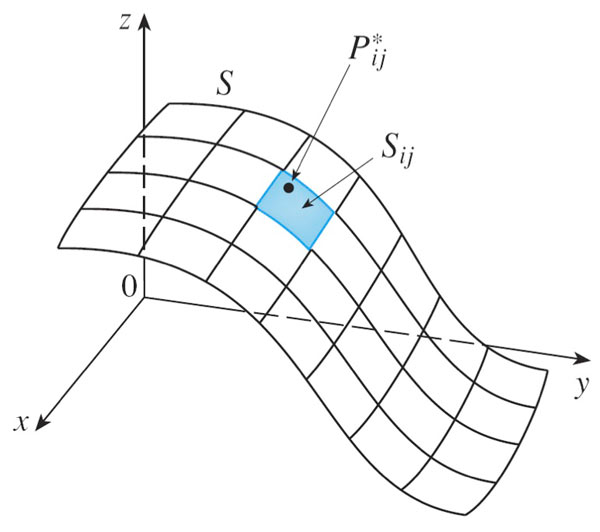
Defining the surface integral in terms of the Riemann sum

Definition
General definition in the parameter space $u$, $v$: $$\iint_S f(x,y,z)\,dS= \iint_D f(\myv r(u,v)) \left|\myv r_u \times \myv r_v \right|\,du\,dv.$$
With $z=g(x,y)$, if we take the parameters to be $x$ and $y$ this turns into $$\iint_S f(x,y,z)\,dS= \iint_D f(x,y,g(x,y))\sqrt{1 + \left(\frac{\del g}{\del x}\right)^2 +\left(\frac{\del g}{\del y}\right)^2 }\,dx\,dy.$$
Oriented surface
We'll shortly be integrating normal components of vector fields.
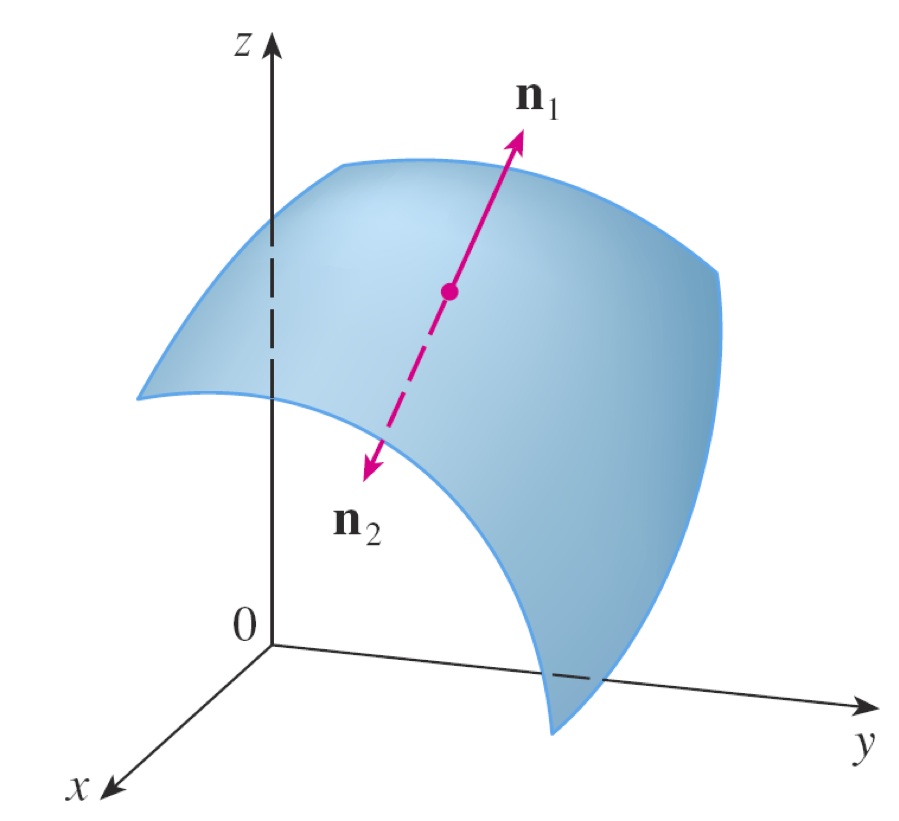 There are two possible surface normal orientations.
There are two possible surface normal orientations.
For closed surfaces we can define a convention for which surface normal to choose.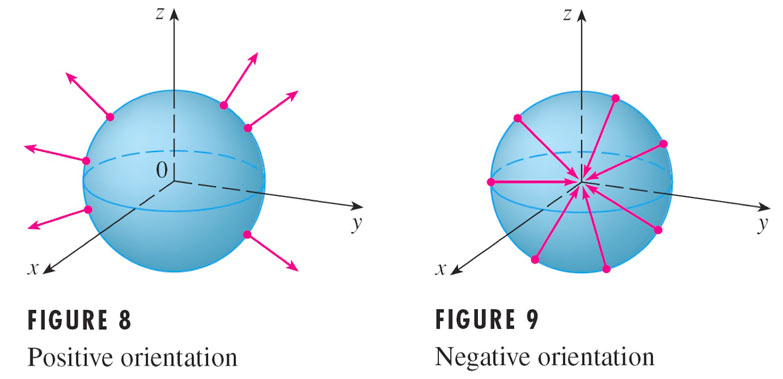
Surface, or flux integral
 If necessary, we will use a simpler convention that the positive normal direction is up.
If necessary, we will use a simpler convention that the positive normal direction is up.
The flux integral or the surface integral of a vector field is $$\iint_S\myv F\cdot \uv n \,dS$$
In terms of the parameters $u$ and $v$,


Vector forms of Green's Theorem
Here again are the vector forms of Green's Theorem: $$\oint_C \myv F\cdot \uv T\,ds = \iint_D \myv \grad \times \myv F \cdot \uv k\,dA. $$ $$\oint_C \myv F\cdot \uv n\,ds = \iint_D \myv \grad \cdot \myv F \,dA. $$
Stokes' Theorem

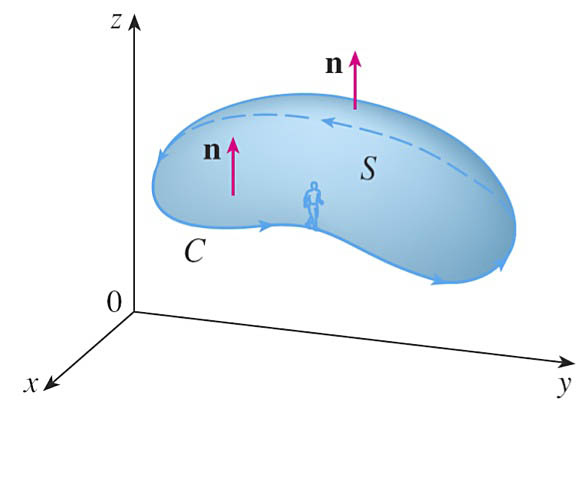
Since... $$\oint_C \myv F\cdot d\myv r=\oint_C \myv F\cdot \uv T\,ds$$ and $$\iint_S\myv \grad \times \myv F \cdot d\myv S=\iint_S\myv \grad \times \myv F\cdot \uv n \,dS,$$ the content of Stokes' theorem is that
- The integral of the circulation density over a surface is equal to
- the circulation around the boundary of the surface.
Meaning of curl / circulation
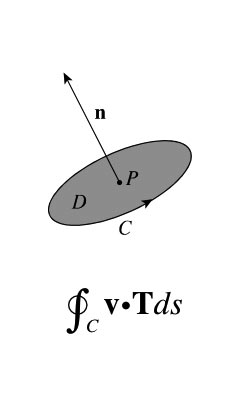 Curl is a measure of circulation per unit area. If the vector field $\myv v$ is the velocity of fluid flow, then the circulation around a circle $C$ is the integral of the tangential component of $\myv v$ around the boundary of the circle.
Curl is a measure of circulation per unit area. If the vector field $\myv v$ is the velocity of fluid flow, then the circulation around a circle $C$ is the integral of the tangential component of $\myv v$ around the boundary of the circle.
Circulation is a measure of the extent to which $\myv v$ maintains the direction of the unit tangent $\uv T$ - the extent to which the flow is rotating in the direction of $C$.
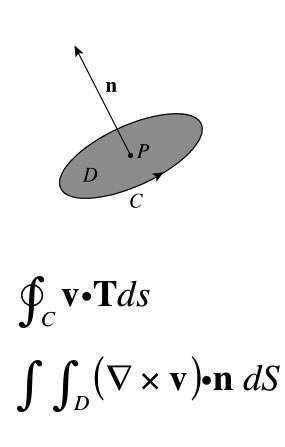 Take a point $P$ within the flow and a disk $D$ with unit normal $\uv n$ surrounding $P$.
Take a point $P$ within the flow and a disk $D$ with unit normal $\uv n$ surrounding $P$.
Stokes' theorem says that the circulation of $\myv v$ around $C$ is approximately equal to the average $\uv n$ component of $\myv \grad \times \myv v$ on $D$ multiplied by the area of $D$.
So the average $\uv n$ component of $\myv \grad \times \myv v$ on $D$ is equal to the circulation around $C$ divided by the area of $D$.
 Integrating $\myv \grad \times \myv F$ for the region shown.
Integrating $\myv \grad \times \myv F$ for the region shown.
- Arrows show the circulation for each patch of surface $\Delta S$.
Inside the large rectangle the rotations cancel so the integration of curl F for the region is equivalent to integrating the flow along the boundary.

The Divergence Theorem

Compare to this vector version of Green's theorem: $$\oint_C \myv F\cdot \uv n\,ds = \iint_D \myv \grad \cdot \myv F \,dA. $$
The divergence at a point is something like the local 'flux density'.
The integral of the flux density over a solid region is equal to the flux through the surface boundary of the region.
Example
 Calculate the flux through just the surface
Calculate the flux through just the surface
$\iint_S \myv F\cdot \uv n \,dS$
where $S$ is the surface with vertices $(9,0,0)$, $(0,9,0)$, $(0,0,9)$,
and the vector field is
$$\myv F(x,y,z)=(x+y^2)\uv i+(y+z^2)\uv j+(z+x^2)\uv k$$
I'll use this form of the surface integral: $$\iint_S f(x,y,z)\,dS= \iint_D f(x,y,g(x,y))\sqrt{1 + \left(\frac{\del g}{\del x}\right)^2 +\left(\frac{\del g}{\del y}\right)^2 }\,dx\,dy.$$
The equation of the plane containing the triangle is.. $$x+y+z=9 \Rightarrow z=g(x,y)=9-x-y$$
- $g_x=g_y=-1$ so the square root factor is $\sqrt{3}$
- the limits of integration are $$\iint_D=\int_{x=0}^9\int_{y=0}^{9-x}$$
The function $f(x,y,z)=f(x,y,g(x,y))$ in the integral is $\myv F\cdot\uv n$.
- The unit normal vector to the plane is $\uv n=\frac{1}{\sqrt 3}\langle 1,1,1\rangle$,
- so $$\myv F\cdot \uv n = \frac{1}{\sqrt 3} \left(x+y^2+y+z^2+z+x^2\right)$$
- substituting in $z=9-x-y$ on the triangular surface, Mathematica expands this to... $$\myv F\cdot\uv n = \frac{1}{\sqrt 3}(90 - 18 x + 2 x^2 - 18 y + 2 x y + 2 y^2)$$
Putting this all together... $$\iint_D\myv F\cdot \uv n dS = \int_{x=0}^9\int_{y=0}^{9-x}(90 - 18 x + 2 x^2 - 18 y + 2 x y + 2 y^2)\,dy\,dx.$$
Example
 Calculate the total flux through *all* the surfaces of the volume bounded byt the triangle, and the planes $x=0$, $y=0$, $z=0$.
with
Calculate the total flux through *all* the surfaces of the volume bounded byt the triangle, and the planes $x=0$, $y=0$, $z=0$.
with
$\iint_S \myv F\cdot \uv n \,dS$
where
$$\myv F(x,y,z)=(x+y^2)\uv i+(y+z^2)\uv j+(z+x^2)\uv k=P\uv i+Q\uv j+R\uv k.$$
This turns out to be significantly easier! We'll calculate it from the right side of the divergence theorem:
∯${}_S \myv F \cdot \uv n dS = \iiint_E \myv \grad \cdot \myv F dV.$
The divergence is $$\myv \grad \cdot \myv F =\frac{\del P}{\del x}+\frac{\del Q}{\del y} +\frac{\del R}{\del z}= 1+1+1=3.$$
So, $$\iiint_E \myv \grad \cdot \myv F dV=3\iiint_E\,dV=3*(9*9*9/3)=729.$$
Example
∯${}_S \myv F \cdot \uv n dS = \iiint_E \myv \grad \cdot \myv F dV.$
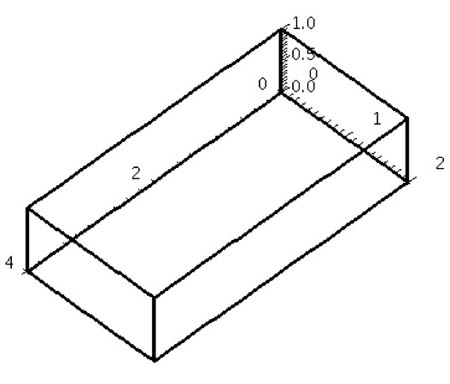 For some function $\myv F=P\uv x+Q\uv y+R\uv j$...
For some function $\myv F=P\uv x+Q\uv y+R\uv j$...
[Normal vectors?]